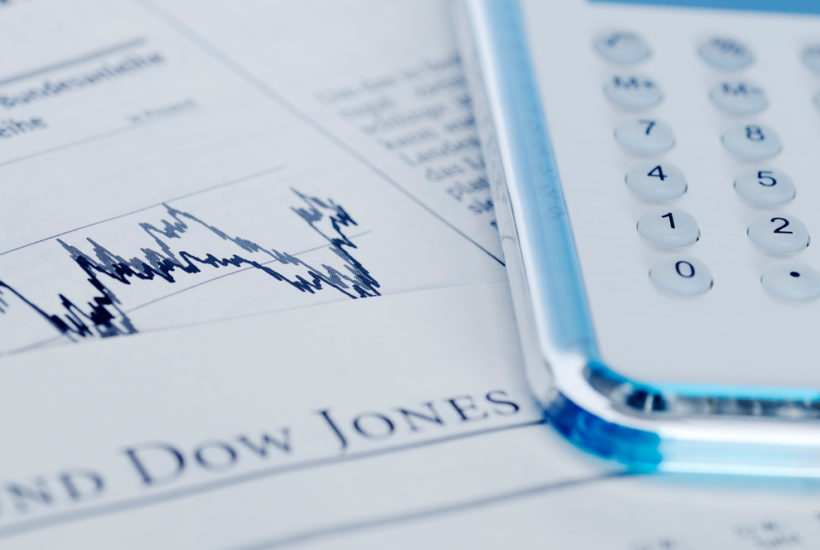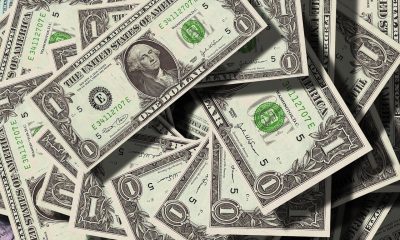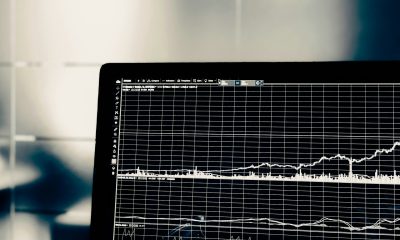Featured
Markets seem to have reached an inflection point
Are we at an inflection point in the markets? The Dow Jones closed the week down 3.20 percent from its last all-time high. On a week where the Federal Open Market Committee (FOMC) cut its Fed Funds Rate by twenty-five basis points (0.25 percent), the Dow Jones deflated 2.59 percent Bear’s Eye View (BEV) points from last week’s close, or down 707.44 dollars.

Back in the late 1990s, even a rumor that Alan Greenspan was even thinking he may cut the Fed Funds Rate by twenty-five basis points caused the bulls on the floor of the NYSE to begin dancing, beating their copper kettles with wooden spoons for joy. Twenty years later we live in a different world.
Certainly, in the past eighteen months, things have changed. Look at all those BEV Zeros (new all-time highs) in the Dow’s BEV chart below from 2013 to the end of 2017. But since the beginning in January 2018 the Dow Jones has seen only four BEV Zeros last autumn, another four this summer, and sandwiched in between these paucities of new all-time highs is the deepest post-March 2009 market correction; an 18 percent decline late last December.
Look at this week’s yield curve (Green Plot below). They cut the Fed Funds by 0.25 percent and yet the yield curve remains as inverted as it was before. If you look at the Fed Funds Rate and 1-year T-Bills, it’s even more inverted than it was in May or June.
Looking at the other major market indexes I follow in the table below, this week’s rate cut did nothing for them either, and look who’s at the bottom; the NASDAQ Bank and NYSE Financial indexes. Not that this is a new development for the NYSE Financial index; this is how it’s been since the 2007-09 credit crisis.
I’m not an active follower of the Dow Jones Theory; the comparison of chart action between Dow Jones Industrials (the Dow Jones #6) and the Dow Jones Transports (the Transports #16). However, seeing the Transports this week decline from -6.87 percent on Monday down to -10.34 percent at the close of the week, well that’s a big double-digit decline that may be telling us something.
The thing that really bugs me about the stock market is how a brilliant market observation, as seen above, can be turned into total nonsense just a week later. It’s embarrassing when it happens, so I try not to make short-term market projections as in the coming weeks we may once again see many of the above indexes at new all-time highs.
I’ve become mechanical in my calls for market tops and bottoms, using Dow Jones’ Days of Extreme Market Volatility (aka 2 percent days) days where the Dow Jones moves more than (+/-) 2 percent from a previous day’s closing price. Until the Dow Jones once again begins seeing Extreme Volatility, multiple big daily moves of 2 percent or more as it did last October to December, I’m going to remain short term bullish on the stock market.
Be-that-as-it-may-be, the Dow Jones in its daily-bar chart below has the appearance of a market in the early stages of falling off a cliff. To be sure some big down days happened last week. But this data consists of daily Open, High, Low and Closing price data, and Wednesday and Thursday saw the Dow Jones move more than 2 percent from their daily highs to lows.
However I compute my volatility by daily closing prices, and on a daily closing price basis, the Dow Jones didn’t see a 2 percent day last week. Don’t worry, when Mr. Bear returns to lower Manhattan to once again feed on market valuations in the stock market, we’ll see plenty of 2 percent days on a closing price basis. And until he does, I’m remaining short term bullish.
But darned if the Dow Jones below doesn’t have the appearance of a market in the early stages of falling off a cliff. Don’t do this to yourself big fellow! Stay strong and stay bullish until Mr. Bear begins stacking up some Dow Jones 2 percent days the honest way.
Let’s go look at volatility in the Dow Jones and its impact on the stock market.
The Dow Jones’ 200-count; the count of Dow Jones 2 percent days within a 200-day running sample, had increased to 18 in early June this year. However, as seen below, most of those days of extreme market volatility have gotten stale since late last year. In the table below, three of the four 2 percent days from last October have expired and now the count is 15. The count will continue to decline unless the Dow Jones once again begins deflating as it had from October to December of last year, as it corrected 18 percent.
There’s an excellent reason for following the Dow Jones’ 200 day count; the Dow Jones (my proxy for the broad stock market) experiences a marked increase in volatility, daily percentage moves of (+/-) 2 percent or more from a previous day’s closing price when Mr. Bear is clawing back market valuation from the bulls.
The chart below plots the Dow Jones’ 200 count since 1900, a 119 history of the 200 count. Every time Mr. Bear deflated the Dow Jones by 40 percent or more, the stock market saw a significant increase in volatility, producing a spike in the 200 count.
The sole exception to that rule was the Dow Jones’ April 1942, -52 percent bear market bottom. After the depressing 1930s (spikes A&B), and with Pearl Harbor happening just four months earlier, obviously not many people were following, or cared about the stock market just months before the Battle of Midway.
April 1942 was also the end of the traumatic era following the Great Depression market crash. As seen in the chart above, from the early 1940s to the early 1970s the stock market saw its lowest levels of market volatility during the 20th & 21st centuries. The Dow Jones from April 1942 to January 1966 appreciated by 970 percent during these twenty-four years.
In August 1971, the US Government took its dollar off the Bretton Woods $35 gold peg (vertical red line). Now freed from the restraints gold imposed on the creation of currency and credit, the Federal Reserve then began a series of inflationary booms in the financial markets (periods of low volatility) followed by the inevitable deflationary busts (volatility spikes C to G) in the financial system.
Here’s a table for the labeled volatility spikes in the chart above. Volatility spike A is unusual as it peaked two months BEFORE the Great Depression’s bear market bottom of July 1932. Unlike Spike A, volatility spikes B-G peaked AFTER the Dow Jones saw its actual bear market bottom.
Looking at the chart and table above, it may appear easy to catch a bear-market bottom in the stock market. As long as you aren’t attempting to catch the absolute bottom, but happy to get back in within 5 or 10 percent of the bottom, I think that’s very possible using this data.
However, the most valuable thing gained by following the Dow Jones’ 200 count is it provides investors with a reliable, time tested model for when to exit the stock market; early in a market decline. Our current advance began over a decade ago. After ten years, 318 percent advance in the Dow Jones, forget about buying more; now is the time to be looking for a reason to sell!
For example, last October seeing the Dow Jones experience not one but four Dow Jones’ 2 percent days from October 10th to 24th was reason enough to exit the stock market. Doing so would have resulted in an 8.37 percent loss in late October; much better than to have waited until late December with its 18 percent correction bottom.
As the chart above covers a 119 year period, which compresses the volatility spikes, let’s examine the Depression Era Dow Jones 200 count with its 8 count (number of 2 percent days in an eight-day count) below. The first thing to notice is though the 200 count peaked in May 1932, the market remained volatile until after December 1933; eighteen months after the Dow Jones Great Depression bottom. Waiting to reenter the market until volatility ceased completely meant missing much of the July 1932 to March 1937 365 percent advance.
If there was one iron rule for following the days of extreme volatility for the Dow Jones, it would be when one sees the Dow Jones in the late stages of a major market advance beginning to produce multiple days of extreme market volatility; the best thing one can do is to reduce one’s exposure to the stock market. As the Dow Jones currently isn’t producing any (+/-) 2 percent daily moves, I remain short-term bullish on the stock market.
However, on a long-term basis, I still believe Mr. Bear intends on taking the Dow Jones down by over 70 percent before he is finished with his work on Wall Street. He may possibly exceed his -89 percent clawback of the Dow Jones seen from 1929 to 1932.
Here’s a BEV Chart for the Dow Jones going back to 1885. A reprise of the Great Depression Crash would be a terrible thing.
Here’s a table listing such a deflation in the Dow Jones by BEV Values, Dow Jones Prices and Point Declines.
Because they did we see historic inflation in market valuations, an inflationary market bubble in the Dow Jones in the chart below. And following such a historic market boom comes the inevitable market bust.
It’s not just valuations in the stock market that Mr. Bear is after. What Mr. Bear really wants is to stress test balance sheets; determine the ability of companies, institutions and individuals who assumed massive levels of debt in the good time to continue to service them when the economy comes under stress. The question is how many famous companies, local governments, and individuals are going to flunk this test?
Since the 2007-09 credit crisis, corporate America has become a glutton for assuming debt, as noted in the article below. How much will a flag-ship blue-chip company’s share trade for at the NYSE or NASDAQ when its bondholders begin bankruptcy proceeding? A whole lot less than they were at the close of this week!
People are never satisfied; that includes me. For six years the -27.5 percent line ($1360) in the BEV chart below functioned as a Line-of-Death for the bulls in the gold market. Then on June 19th (32 COMEX trading sessions ago) gold broke above this critical line and hasn’t been anywhere near it since.
I ought to be happy, but I wasn’t as I want gold to do something spectacular. But this week I’m feeling a bit perky for what I saw in the chart below, generously provided by the fine folks at Kitco.
On Tuesday (Blue Plot) after breaking above $1430 in after-hours trading, the price of gold manhandled down.
On Wednesday during New York’s COMEX trading (Gold Plot) they broke gold below $1430, and in the after-hours the price of gold began a collapse that didn’t end until gold touched $1400 in early Thursday trading (Black Plot), when out of nowhere gold moved up almost $50 from 9 AM to 6 PM.
All we need now are some days of extreme volatility in the gold market, days where gold moves 3 percent or more from a previous day’s close to once again get the price of gold heading up to new all-time highs.
I and other pro-gold market commentators spend most of our time on gold and silver, but there is also platinum and palladium to consider. So I constructed the chart below plotting these four precious metals indexed to 1.00 = August 1993 to see which metal is doing best, and so far it’s been palladium (Purple Plot).
At the close of this week, it appears we may have arrived at an inflection point in the markets.
The stock market may have peaked and possibly could soon be coming down in a major way. But I don’t want to assume this to be so at this time for lack of 2 percent days in the Dow Jones
And gold, having defeated the best efforts to break it down below $1400 this week, closed only a few dollars from its highs of the advance. But I need to see even more of the same to believe this break out is destined to take gold to new all-time highs.
Next week should be very interesting.
(Featured image by DepositPhotos)
—
DISCLAIMER: This article expresses my own ideas and opinions. Any information I have shared are from sources that I believe to be reliable and accurate. I did not receive any financial compensation for writing this post, nor do I own any shares in any company I’ve mentioned. I encourage any reader to do their own diligent research first before making any investment decisions.

-

 Fintech2 weeks ago
Fintech2 weeks agoSwiat Secures BaFin Approval and Accelerates Europe’s Digital Securities Infrastructure
-

 Crowdfunding6 days ago
Crowdfunding6 days agoFlower Burger Launches Crowdfunding to Fuel Growth in Booming Plant-Based Market
-

 Biotech2 weeks ago
Biotech2 weeks agoNurExone’s Exosome Platform Gains Global Spotlight with Dual 2025 Award Nominations
-

 Business4 days ago
Business4 days agoThe TopRanked.io Weekly Digest: What’s Hot in Affiliate Marketing [K4G Affiliates Review]
























